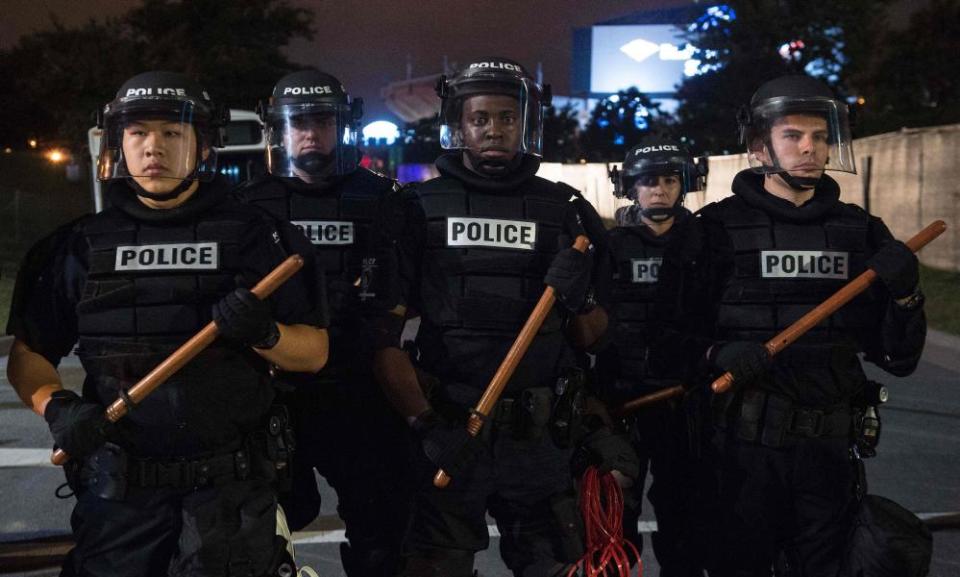Where does police brutality fit in America's first law enforcement museum?
The Washington institution is likely to spark debate over whether it gets the tone right in an era of police shootings and allegations of racism

In narrative terms, it is like threading a needle. America’s first museum dedicated to law enforcement cannot avoid the racially charged subject of Ferguson, Missouri, where a white police officer killed an unarmed black teenager in 2014.
From Saturday, when the collection in Washington opens to the public, the museum is likely to spark intense debate over whether it gets the tone right in an era when police shootings and allegations of racism have often dominated news headlines.
“[Ferguson] spurred protests and a national debate about law enforcement and race,” an information panel says. “A grand jury did not indict the officer. The Department of Justice concluded that he acted in self-defense. It did find systematic discrimination against African Americans by the city of Ferguson and its police. Since then officer-involved shootings have headlined the news, prompting agencies to adopt new practices, such as de-escalation training and body cameras.”
Twenty years in the making, the $100m National Law Enforcement Museum is the new kid on the block in Washington’s already crowded museum marketplace: on the nearby national mall alone, the Smithsonian Institution runs 11 free museums and galleries, while directly opposite sits the dauntingly grand National Building Museum.
For the most part the museum is uncritical and steers clear of politics, but there is a nod towards the tensions between law enforcement and African American communities. A newspaper headline, “No Indictment in Ferguson Teenager’s Killing”, sits beside the “12 Officers Shot, 5 Dead, in Dallas Police Ambush” – a reference to a 2016 attack by an army reservist said to have been angered by police shootings of African American men.
The display case includes a police body camera (“footage of the same event can tell different stories”) and uniform worn by Captain Ron Johnson, who took over security operations in Ferguson and abandoned swat trucks and riot armour in favour of walking with demonstrators. The rosary beads and buckeye nut that Johnson carried to relieve stress are also on show.
Asked if the police have a public relations problem, and if the museum is aiming to help solve it, chief executive Craig Floyd said: “I think this museum will become a platform for very thoughtful, important discussions that need to occur between the public and law enforcement. We have a lot of those programmes already planned.”
For about seven years, he continued, the National Law Enforcement Officers Memorial Fund has held public programmes that tackle topical issues, such as the pros and cons of body cameras. “We talked about the use of force and we had community activists, African American leaders from different communities and law enforcement leaders talking about what they do, why they do it, how they do it.
“We heard from the community activists about what they might do differently to improve relations with the communities they serve. I think it has been very productive and we’re going to do a lot more of that here in this museum.”
The building spans 57,000 sq ft and the collection has more than 21,000 artifacts, including a US Park Police Eagle One helicopter suspended from the ceiling and an Indiana state police Dodge Charger open to all comers. Bright and airy despite being mostly underground, the museum does offer attractions that can’t be found elsewhere in Washington or beyond.
There is a book containing “acts and laws of Massachusetts Bay, 1759”, a handgun, badge and coin case thought to have belonged to the old west lawman Pat Garrett, Al Capone’s revolver, special agent Eliot Ness’s credentials (prohibition was the deadliest era in law enforcement history), FBI director J Edgar Hoover’s desk, chair and phone, the phone that in 1968 received the first 911 call, and, perhaps most unexpectedly, Osama Bin Laden’s pakol hat, “illegally grabbed” as a trophy by a Navy Seal during the 2011 raid that killed him.
An area devoted to film and TV portrayals of law enforcement includes the costume from Robocop 2 and a sweatshirt worn by counter terrorist agent Jack Bauer (Kiefer Sutherland) from the drama 24. An original toilet/ sink unit, bed, wall locker, foot locker, light fixture and grate have been brought from a prison and set up in a recreated cell (on the bed, a Time/ Life magazine has the front page headline “Great prison escapes”).
A temporary exhibition space is currently devoted to five community-oriented policing programmes in Charleston, Chicago, Cleveland, Dallas and Somerville. “We’ll bring in live canines on the weekends to display their talents and skill sets,” Floyd said. Tuesday’s media preview was punctuated by loud barking from a four-year-old police dog called Dux.
The museum – which contains a hall of remembrance with pictures of officers killed in the line of duty – does not receive taxpayer funding. Some 88 donors gave $100,000 or more. Motorola Solutions, the communications company, and its foundation gave $18m and its name features prominently.
Back in the historical gallery, a striking red and white plaque declares: “We demand an end to police brutality now!” It is actually from the 1960s – proof again of how history often rhymes.

